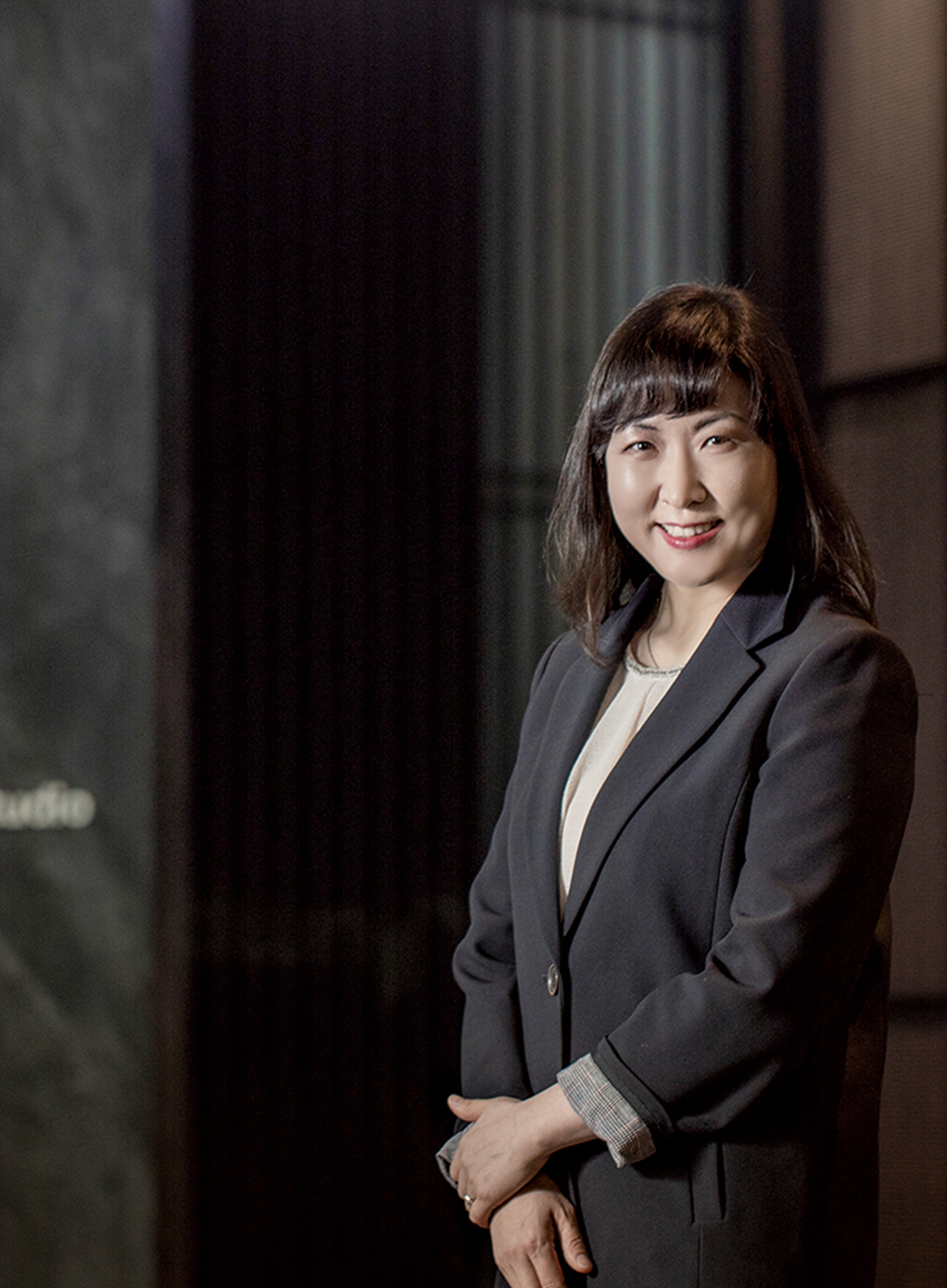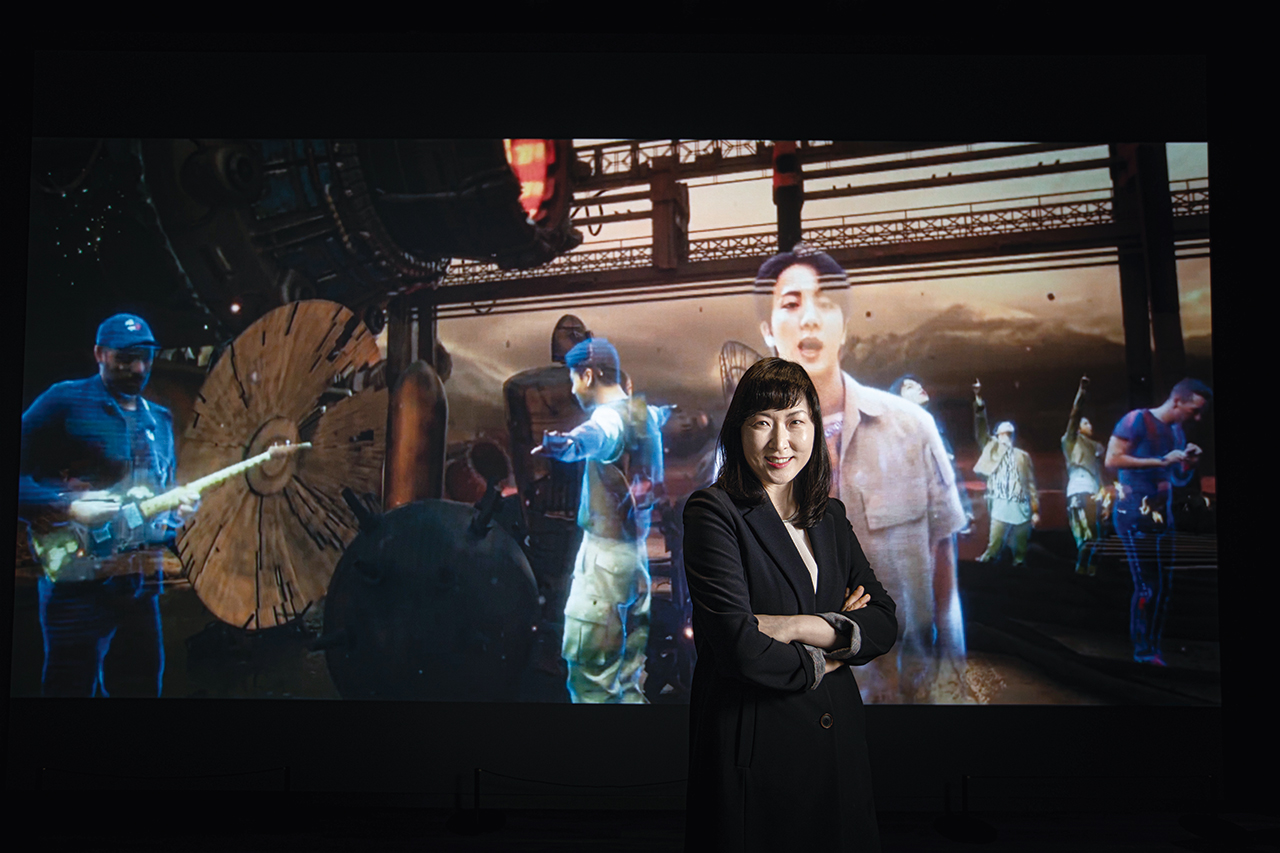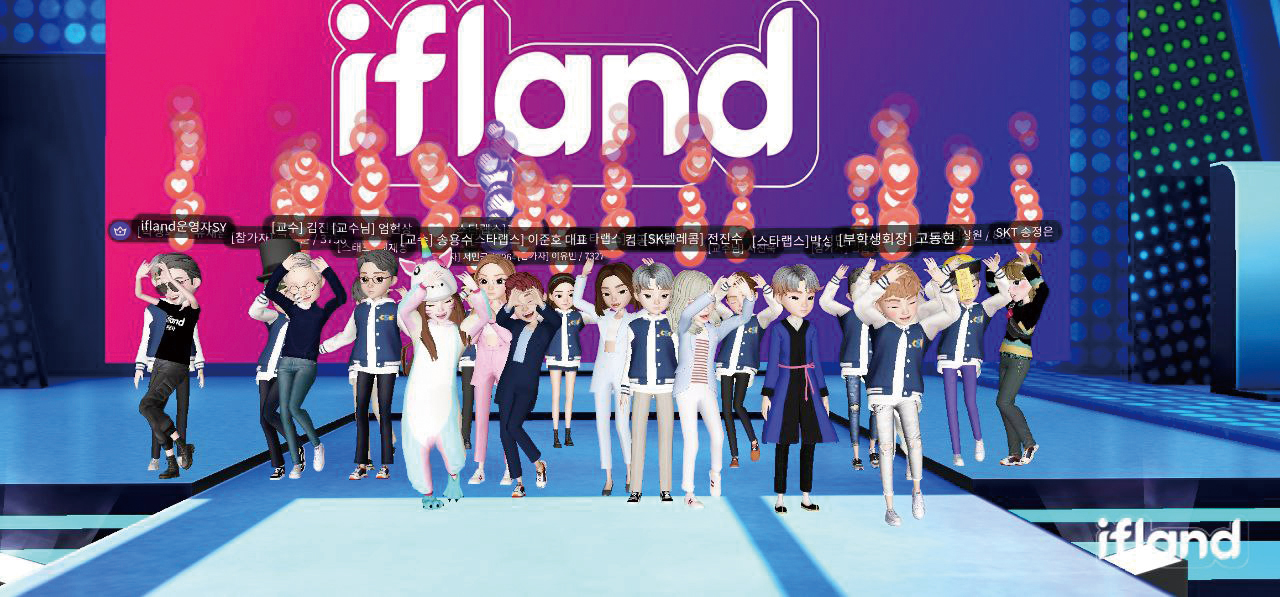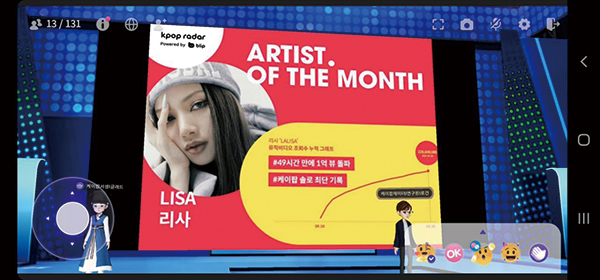Contents VOL. 260

COVER STORY
코로나19 사태가 장기화되며 사회적 거리두기, 비대면 활동이 이어지고 있습니다. 자유롭지 못한 상황 속에서, 현실의 한계를 뛰어넘는 3차원 가상세계 ‘메타버스’가 새로운 트렌드로 떠오르고 있습니다. 2022년에 더욱 주목하게 될메타버스에 대해 알아봅니다.

코로나19 사태가 장기화되며 사회적 거리두기, 비대면 활동이 이어지고 있습니다. 자유롭지 못한 상황 속에서, 현실의 한계를 뛰어넘는 3차원 가상세계 ‘메타버스’가 새로운 트렌드로 떠오르고 있습니다. 2022년에 더욱 주목하게 될메타버스에 대해 알아봅니다.
Scroll Down
The new world of the metaverse has already come before us. Now is the time to actively accept and enjoy the metaverse, says Jeon Jin-soo, Head of Metaverse Company, who worked on the development of AR and VR technology and now leads the metaverse business at SK Telecom. She also stresses that now both businesses and individuals need to show their abilities in a world of the metaverse.

SK텔레콤 전진수 메타버스CO장
Jeon Jin-soo, Head of SK Telecom Metaverse Company
지난 11월 국제게임전시회 ‘지스타’가 열렸다. 올해의 지스타 콘퍼런스를 뜨겁게 달군 키워드는 단연 메타버스. 특히 SK텔레콤에서 메타버스 사업을 총괄하는 전진수 메타버스CO장이 2일 차 키노트 세션에서 ‘메타버스가 가져올 일상과 산업의 변화’라는 주제로 기조연설에 나서 큰 관심을 끌었다. 전진수 CO장은 오늘날 메타버스를 구성하는 주요 요소로 ‘아바타’, ‘가상공간’, ‘활동’, ‘창작’, ‘경제’를 꼽았다. 이제 메타버스는 실생활과 자연스럽게 섞여 가고 있다. 더 이상은 남의 얘기가 아닌 만큼, 보다 적극적으로 받아들이고 즐겨야 할 때다. 최근 들어 미래 산업의 주 무대로 부상한 메타버스. 그 배경은 무엇일까.
“몇 가지 이유를 들 수 있습니다. 우선, 5G 이동통신이 상용화되면서 대용량의 메타버스 콘텐츠를 빠르게, 지연 없이 전달할 수 있는 인프라가 구축됐습니다. 그리고 빅테크 기업들의 대규모 투자로 관련 기술들이 발전했죠. 과거에는 명확한 한계가 있었습니다. 과거의 AR 디바이스는 발열이 심하고, VR 디바이스는 무거워서 이용하기 힘드니 사용자 경험이 좋을 리 없었죠. 하지만 이제 GPU나 배터리 성능, 클라우드, 광학, 트래킹, 비전 AI 기술 등이 모두 소비자가 수용 가능한 수준으로 빠르게 발전하고 있습니다.”
이런 급격한 기술의 발전 외에 비대면 문화를 일거에 확산시킨 코로나19 등 사회문화적 영향도 빼놓을 수 없다. 전진수 CO장은 코로나19 사태와 더불어 디지털 네이티브 혹은 메타버스 네이티브라 불리는 MZ세대들의 수용도가 높아지면서 메타버스가 더 가속화됐다고 덧붙였다.
“이전에도 로블록스, 마인크래프트 같은 게임이나 영상통화, 줌과 같은 온라인 소통 서비스들은 존재했습니다. 하지만 ‘굳이 왜?’라며 의문을 제기하는 사람들이 더 많았어요. 그러다 코로나19 이후 모든 것이 온라인으로 전환되자 부정적이던 사람들까지 이런 서비스를 적극적으로 사용하게 됐습니다. 유저가 확대되자 시장이 열리기 시작했고, 메타버스 안에서 사는 MZ세대가 등장했죠. 기성세대들은 새로운 기술에 진입하기 위해 습득할 시간이 필요하지만, MZ세대는 따로 배우지 않아도 메타버스를 일상으로 받아들이니 시장이 빠르게 성장하는 데 일조할 수 있었습니다.”
In November, the Global Game Exhibition “G-Star 2021” took place. The hottest keyword of this year’s event was of course the “metaverse.” And greater attention was paid to the opening statement on, “How the metaverse will change our daily life and industries,” in the second day’s keynote session by Jeon Jin-soo, Head of SK Telecom Metaverse Company, who are in charge of metaverse businesses of the company. Jeon cited “avatar,” “virtual space,” “activity,” “creation,” and “economy” as major components of the metaverse. Today, the metaverse is naturally being mixed with our real life. Since we can no longer ignore or avoid it, now is the time to actively accept and enjoy the metaverse. And the metaverse has recently emerged as a main stage for the future industry. What is behind this trend?
“There are several reasons. First of all, the commercialization of 5G network has contributed to the establishment of the infrastructure, where a large amount of metaverse related content can be delivered fast, without delay. And the large investment by Big Tech firms has enabled the advancement of the relevant technologies. There was a clear limit in the past: AR devices in the past tended to heat up so fast and VR devices were too heavy to use, which made user experience worse. But now technologies including GPU, battery performance, Cloud, optical technology, tracking technology, and vision AI technology, have all been advancing so fast as to be acceptable for users.”
Aside from such rapid advancement of technologies, social and cultural impact, including COVID-19, which spread the contact-free culture at once, has also played a significant role in the development of the metaverse. Jeon says the metaverse has been accelerated not only with the COVID-19 pandemic, but also with the MZ generations, or Gen MZ, a digital native or metaverse native generation, who is opening their mind more to the metaverse.
“Online communication services, including games like Roblox and Minecraft, video calls, and Zoom, already existed in the past. But most people didn’t understand the meaning of such services, just asking ‘Why?’ And then, everything began to be done online due to COVID-19, and all people, even those who were skeptical about them, began to use the services actively. The expansion of users has led to the opening of the market, and the MZ generation appeared, who live in the metaverse. The older generation needs time to learn before utilizing new technologies, while Gen MZ can accept the metaverse as part of their daily life without learning it, helping the rapid growth of the metaverse market.”
이러한 이유로 글로벌 빅테크 기업들이 메타버스에 대한 투자를 아끼지 않고 있다. 가히 열풍이라 불릴 만하다. 국내에서도 메타버스 주 이용자 층인 10~20대를 타깃으로 삼는 패션, 게임, 엔터테인먼트, 유통, 방송, 교육 분야 기업들뿐 아니라 공공, 국방, 의료 등 다양한 분야의 사업자들이 서둘러 메타버스에 탑승하고 있다.
예를 들어 엔터테인먼트사들은 메타버스 안에 소속 연예인에 특화된 전용 가상공간을 만들고 콘서트, 팬미팅 등을 개최하고 있다. 유통업체나 제조업체는 메타버스 안에 쇼룸을 만들어 제품을 홍보하고, 박물관과 미술관은 가상 전시회를 열고 있다. 메타버스에서 입학식이나 오리엔테이션을 개최하는 대학, 신입사원 채용설명회나 워크숍을 진행하는 기업도 생겼다. 한국관광공사는 익선동, 한강공원 등 서울의 관광지를 모사한 가상공간을 만들고 한국 여행 홍보 이벤트를 진행한 바 있다.
SK텔레콤은 지난 7월 가상공간과 아바타를 이용해 메타버스 경험을 극대화하는 메타버스 플랫폼 ‘이프랜드’를 출시했다. 이프랜드의 특장점은 누구나 쉽고 간편하게 이용할 수 있도록 프로세스를 간소화하고 사용자 편의성을 높였다는 점이다. 이는 SK텔레콤이 과거 ‘소셜 VR’, ‘버추얼 밋업’ 같은 서비스를 운영하며 다년간 기술과 노하우를 축적해온 덕분이다.
“글로벌 빅테크 기업들의 움직임이 심상치 않아 저희도 10여 년 전부터 기술 개발을 시작, 5G 상용화 기점을 전후해 다양한 서비스로 메타버스를 준비해왔습니다. 하지만 기술과 저변이 충분히 형성되지 않은 탓에 시장의 반응은 미미했죠. 그렇게 실패의 경험들이 축적됐기에 오늘의 이프랜드가 탄생한 것이라 생각합니다. 메타버스를 통해 고객은 기존의 2D 기반 경험을 3D로 경험해야 합니다. 뚝딱 완성할 수 있는 기술이나 서비스가 아니죠.”
실패를 거듭한 끝에 메타버스 콘텐츠를 쉽게 제작하고 관리할 수 있는 T리얼 플랫폼을 개발해냈다. AR과 VR이 혼합된 3차원 콘텐츠를 제작하는, 아시아 유일의 혼합현실 스튜디오(Microsoft Mixed Reality Capture Studio)인 ‘점프 스튜디오’도 열게 됐다. 점프 스튜디오에서는 106대의 카메라를 통해서 360도 촬영이 가능하며 자연스럽게 움직이는 고화질 3D 홀로그램을 생성할 수 있다. 최근 화제를 모은 BTS와 콜드플레이의 뮤직비디오도 3D 홀로그램 기술을 활용했다. 각자 다른 곳에 있는 아티스트가 한 공간에서 공연하는 모습을 구현한 것이다. 이 중 BTS의 멤버를 촬영한 곳이 바로 이 점프 스튜디오다.
For these reasons, global Big Tech companies have spared no investment in the metaverse. The situation can be called a “craze.” In Korea, fashion, game, entertainment, distribution, broadcast, education companies targeting people in their 10s and 20s, major users for the metaverse, as well as other businesses in public, military, and medical sectors have all rushed into the metaverse.
For example, entertainment agencies create a virtual space exclusively for their artists in a metaverse space and hold events like concerts and fan meetings there. Distribution companies and manufacturers make a showroom to promote their products in a digital space, and museums and galleries present virtual exhibitions. Some universities have held the entrance ceremony and orientation for new students, and some companies have held their recruitment fairs and workshops in the metaverse. The Korea Tourism Organization created virtual spaces imitating tourist destinations in Seoul, such as Ikseon-dong and Hangang Park, to promote Korean tourism.
In July, SK Telecom launched a metaverse platform, “ifland,” which maximizes the metaverse experience using virtual spaces and avatars. What makes ifland special is that it simplifies the process to make it more user-friendly so that anyone can easily access the system. This is attributable to years of technologies and experiences that SK Telecom has accumulated while operating services like “Social VR” and “Virtual Meetup” in the past.
“Since global Big Tech firms seemed to show some movements, we began to develop the technology a decade ago, preparing for the metaverse through various services with the commercialization of 5G service. However, the market did not show interest because the technology and user base were not sufficiently secured. These experiences of failure contributed to the birth of ifland. Through a metaverse platform, users should experience what they used to do in 2D settings in a 3D space. The technologies and services behind that are not something to be easily developed in the blink of an eye.”
After repeated failures, SK Telecom has eventually developed T Real Platform, which allows users to easily create and manage metaverse content. And it has also opened “Jump Studio,” Asia’s first Microsoft Mixed Reality Capture Studio that helps create 3D content combined of AR and VR. At Jump Studio, naturally moving, high-quality 360-degree 3D holograms can be created by using 106 cameras. The recent music video of BTS and Coldplay took advantage of the 3D hologram technology to show as if the artists, who were actually in different places, were performing in the same space. For the music video, members of BTS were filmed in the Jump Studio.


이프랜드 론칭 후 1개월 만에 1천여 곳의 기업들이 협업 제의를 할 만큼 메타버스에 대한 국내 기업들의 관심은 뜨거웠다. 현장에서 누구보다 그 열기를 실감한다는 전진수 CO장. 하지만 그는 조급함을 버려야 한다고 당부했다.
“메타버스 시대가 열린다니 아무것도 하지 않으면 도태될 거라고 위기감을 느끼는 기업이 많습니다. 하지만 A부터 Z까지, 뭐든 다 하려는 조급함은 해결책이 될 수 없어요. 메타버스는 방대한 시장입니다. 업의 본질과 자사 핵심 역량에 대한 파악, 그리고 메타버스를 어떻게 접목시켜야 할지 구체적으로 고민하는 것이 가장 좋은 접근법이라고 생각합니다.”
예를 들자면, 사람들을 연결하는 데 능한 페이스북은 메타버스를 새로운 소통의 채널로, 엔터프라이즈(Enterprise) 사업에 강한 마이크로소프트는 업무 환경을 향상시키는 데 활용한다는 식이다. 마지막으로 전진수 CO장은 메타버스 시대를 슬기롭게 맞이하기를 바라는 마음으로 한양인들에게 무엇이든 시도해 볼 것을 주문했다.
“평소 제가 많이 쓰는 표현이 있습니다. 바로 ‘러닝 바이 두잉(Learning by Doing)’입니다. 일단 작은 부분이라도 직접 부딪쳐 보는 것이 중요합니다. 콘텐츠를 만드는 사람이라면 메타버스 안에서 콘텐츠를 만들어 보고, 개발자라면 메타버스의 한 요소를 만들어 보는 거죠. 그렇게 스스로 배우는 것이 메타버스라는 새로운 세계를 빨리 이해할 수 있는 방법이라고 생각합니다. 그러다 보면 메타버스 세계 안에서, 어느새 중추적인 역할을 맡게 되지 않을까요?”
Korean companies have showed great interest in the metaverse to the extent that more than a thousand companies asked collaborations only within a month of the ifland launch. Jeon, who has realized the popularity more vividly than anyone, stresses that we should not hurry too much.
“Some companies feel that they will be left behind if they don’t do anything about the metaverse. But rushing to do everything from A to Z cannot be a solution. The metaverse is a vast market. The best approach to the market would be to identify the nature and core capability of the business, and then to come up with the ideas of how to apply the concept of the metaverse to the business.”
For instance, Facebook can use the metaverse as a new channel to communicate since it is good at connecting people, and Microsoft, specialized in enterprise business, can utilize the metaverse to improve the working environments. Lastly, Jeon encourages students at Hanyang University to try anything in hope that they enter the metaverse era in a smart manner.
“There is an expression that I often use: ‘Learning by Doing.’ It’s important to attempt to do even in a small part on your own. I mean if you are a content creator, create content in a metaverse space, and if you are a developer, develop a component of the metaverse. By doing that, you can learn by yourself, and I think that is the best way to understand the new world of the metaverse. Then, at some point, you might be playing a pivotal role in the metaverse.”




한양대학교 ERICA캠퍼스 컴퓨터공학과 학부 및 석사를 마치고 삼성전자 소프트웨어센터에 입사했다. 자바 버추얼 머신, 소프트웨어를 개발했고, 피처폰 시절 최초의 게임 플랫폼을 시작으로 플래그십 모델들의 플랫폼을 개발, 상용화시켰다. 스마트폰으로 전환된 후에는 안드로이드 플랫폼과 시스템 개발을 맡았다. 2011년 말 SK텔레콤 ICT기술센터로 전직해 AR, VR, 실감 미디어 개발에 매진했다. AR·VR 사업을 담당하는 미디어랩스장과 5GX서비스단장 및 5GX서비스사업본부장을 거쳐 현재 MNO(이동통신) 사업부 메타버스 총괄 CO장을 역임하고 있다.
Jeon Jin-soo received a bachelor’s and master’s degree in the Department of Computer Science and Engineering at Hanyang University ERICA Campus, and joined the Software Center of Samsung Electronics, where she developed Java virtual machines and software, and developed and commercialized the platforms for Samsung’s flagship models as well as the first game platform for the feature phones. After smartphones were developed, she took charge of the development of Android platforms and system. In the late 2011, she moved to the ICT Technology Center of SK Telecom and worked on the development of AR/VR and immersive media. Formerly the Head of Media Labs for AR/VR business and Director of 5G Service and Business, now she is the Head of Metaverse Company under MNO Business of SK Telecom.